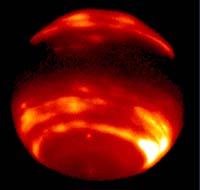| . |  |
. |
 Livermore - January 25, 2000 - The best Earth-based images ever taken of Neptune and Titan, Saturn's largest moon, were presented at the annual meeting of the American Astronomical Society in Atlanta in mid January.
Livermore - January 25, 2000 - The best Earth-based images ever taken of Neptune and Titan, Saturn's largest moon, were presented at the annual meeting of the American Astronomical Society in Atlanta in mid January.The images of the distant celestial bodies were captured in infrared light using the W.M. Keck II telescope in Hawaii, the world's largest. They are among the first Keck images taken with adaptive optics technology, which uses rapid mirror adjustments to remove Earth's atmospheric turbulence from the telescope's images, producing unprecedented clarity. Taken in the past months, the images surpass what would be possible using even the Hubble Space Telescope. They reveal giant Neptunian storms driven by prevailing winds of 600 miles per hour. The Titan images reveal features that could be frozen landmasses separated by chill hydrocarbon seas and lakes. The images are the work of a team of researchers led by Dr. Claire Max of the U.S. Department of Energy's Lawrence Livermore National Laboratory, and include scientists from the University of California at Berkeley, UCLA, and Keck Observatory. The work was supported by the Energy Department, the National Aeronautics and Space Administration and the National Science Foundation's Center for Adaptive Optics. The Keck I and II telescopes are operated by the California Association for Research in Astronomy. Neptune and Titan were chosen as early subjects for Keck's new adaptive optics system because they are bright but mysterious objects of which little is known, but which offer enticing spatial detail. On Neptune, a giant gas ball of a planet 2,800,000,000 miles from Earth, Keck's infrared detectors penetrated into the deep layers of the planet's roiling atmosphere, where giant storms are born of the heat generated by the planet's still-contracting core. Storm features are pulled completely across the face of the planet as Neptune whirls through its 16-hour day. At the north pole, a mysterious haze crowns the planet. Keck's adaptive optics images of Neptune are helping scientists study the planet's storms and their evolution, a first step toward understanding Neptune's weather and climate. "Neptune is one of the most dynamic of the giant planets," said Dr. Bruce Macintosh of the Livermore Lab. "It's always changing. Being able to study it from the ground on a continuous basis, rather than waiting for a spacecraft to fly by, is a huge advantage." The images of Titan will tell astronomers about the complex surface composition of the Saturnian moon, a frigid world some 800 million miles from the sun. Titan has a nitrogen-rich atmosphere similar to that of the early Earth. Sunlight shining on this atmosphere produces a deep orange haze that obscures Titan's surface from view at visible wavelengths. Livermore scientists Macintosh and Dr. Seran Gibbard have been studying Titan for several years at Keck using earlier image processing techniques and computer models. But Keck's new adaptive optics images, taken in infrared light, have much greater sensitivity. They pick out features "that may be cold hydrocarbon seas and lakes," said Gibbard. Other features might be highlands, and one dark area appears to be a large impact crater or great basin. In 2004 the Cassini spacecraft, built by NASA and the European Space Agency, is scheduled to land the Huygens probe on Titan. Keck's new images will help researchers determine beforehand whether the probe will plunge into the first extra-terrestrial sea or land on a solid surface. "Combining the power of Keck with adaptive optics is taking us to new worlds," said Livermore's Max. "That's an extremely exciting prospect as we enter the next millennium." Adaptive optics works by using a continuously deformable mirror and a lightwave sensor to correct light beaming into a telescope. The sensor determines how much Earth's atmosphere is disturbing the light reaching the telescope, and relays this information to the deformable mirror, which corrects the image every few milliseconds. Lawrence Livermore researchers worked with Keck scientists on installation of the Keck adaptive optics technology. In coming months, a new spectrograph will be added to the Keck adaptive optics system. This will help answer questions about the chemical composition and physical state of the features newly seen on Neptune and Titan. Founded in 1952, Lawrence Livermore National Laboratory is a national security laboratory, with a mission to ensure national security and apply science and technology to the important issues of our time. Lawrence Livermore National Laboratory is managed by the University of California for the U.S. Department of Energy.
SPACE SCIENCE
|
| |||||||||
| The content herein, unless otherwise known to be public domain, are Copyright 1995-2016 - Space Media Network. All websites are published in Australia and are solely subject to Australian law and governed by Fair Use principals for news reporting and research purposes. AFP, UPI and IANS news wire stories are copyright Agence France-Presse, United Press International and Indo-Asia News Service. ESA news reports are copyright European Space Agency. All NASA sourced material is public domain. Additional copyrights may apply in whole or part to other bona fide parties. Advertising does not imply endorsement, agreement or approval of any opinions, statements or information provided by Space Media Network on any Web page published or hosted by Space Media Network. Privacy Statement All images and articles appearing on Space Media Network have been edited or digitally altered in some way. Any requests to remove copyright material will be acted upon in a timely and appropriate manner. Any attempt to extort money from Space Media Network will be ignored and reported to Australian Law Enforcement Agencies as a potential case of financial fraud involving the use of a telephonic carriage device or postal service. |